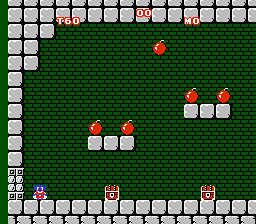
Mighty Bomb Jack (1987-)
Developer: Tecmo
Publisher: Tecmo
Genre: Platform
Mighty Bomb Jack was developed and published by Tecmo for the Nintendo Entertainment System, released in Japan in 1986 and in North America and Europe the following year. The game served as a sequel to the 1984 arcade title Bomb Jack, expanding upon its predecessor’s mechanics and introducing new exploration-based elements. While the original arcade game focused on short, high-score-driven stages, the NES version offered a more extensive adventure spanning sixteen levels set within the pyramids of ancient Egypt. The game’s combination of platforming precision, item collection, and secret-finding marked a shift from the straightforward arcade formula toward a deeper console experience.
Players take control of Jack, a superhero tasked with rescuing the royal family of Pamera from the demon Belzebut, who has imprisoned them within a vast pyramid. The gameplay blends side-scrolling platforming with a focus on collecting bombs and treasure while avoiding or outsmarting enemies. Each stage features multiple layers, hidden rooms, and secret exits that reward exploration and memorization. Jack’s ability to perform variable-height jumps adds a layer of control and challenge, as players must balance risk and timing to avoid traps and enemies. In addition, collecting bombs in specific sequences or uncovering hidden treasures can trigger secret bonuses and warp points, enhancing the game’s replay value.
The game’s design drew inspiration from classic Egyptian themes and Tecmo’s fondness for high-energy arcade action. Unlike many other NES platformers of the time, Mighty Bomb Jack employed non-linear progression, allowing players to uncover alternate routes and endings based on their performance. Its difficulty level was notably high, demanding precise jumps and quick reflexes while punishing careless play with sudden resets or penalties. Despite this, its colorful graphics, tight controls, and sense of mystery made it a standout among early NES action titles. The game’s hidden mechanics, including secret rooms accessible only through specific actions, reflected Tecmo’s design philosophy of rewarding persistent and observant players.
The soundtrack, composed by Kinuyo Yamashita—who would later become known for her work on Castlevania—featured energetic and adventurous themes that matched the game’s fast pace and ancient setting. The lively background music added tension and excitement to each stage while providing a sense of continuity between levels. Upon release, Mighty Bomb Jack received positive attention for its graphics and gameplay depth, though its difficulty proved divisive. It maintained a cult following over the years, appearing later on platforms such as the Nintendo Wii Virtual Console and the Nintendo Switch Online NES library. While it did not receive a direct sequel, the character of Jack and the Bomb Jack concept remained a notable part of Tecmo’s early history, representing a bridge between their arcade roots and console-era experimentation.
Images from MobyGames
Buy Mighty Bomb Jack
Click one of the Ebay or Amazon buttons below to check the latest prices and purchase Mighty Bomb Jack for the Nintendo Entertainment System.

Related Searches
Mighty Bomb Jack NES Download
Mighty Bomb Jack is available to purchase and download from a range of vendors. Always shop around...
Mighty Bomb Jack NES Manual
Various repositories around the internet have scanned and archived a range of retro manuals. Search now to.....
Mighty Bomb Jack NES Rom
We don't host or link to rom sites for this game. However, there are many sites out there that may be...
Mighty Bomb Jack NES Walkthrough
Many sites - particularly YouTube - host a range of walkthrough videos to guide you in your quest to get...
Mighty Bomb Jack NES Cheats
There are various sites out there that can offer cheat codes for games. Search now to find all available...
Mighty Bomb Jack NES Controls
This information can often be obtained through the user manual. Alternatively there are many sites out there...
Mighty Bomb Jack NES Release Date
The initial release date for Mighty Bomb Jack is stated as July 1987. Other ports of the game may..
Mighty Bomb Jack NES Review
There are many sites out there that have collated and documented historic reviews of this game. Search now...
Mighty Bomb Jack Famicom
As a Nintendo Entertainment System release, this game was also likely also available on the Famicom. This....
Mighty Bomb Jack NES Speedrun
There is now a community of competitive speedrunners who will try and gain the fastest possible time on their....








